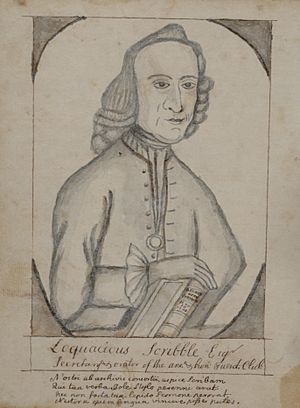Alexander Hamilton (Maryland doctor) facts for kids
Dr. Alexander Hamilton (born September 26, 1712 – died May 11, 1756) was a doctor and writer. He was born in Scotland but lived and worked in Annapolis, colonial Maryland. This was in the 1700s. Historians say his travel diary, Gentleman's Progress: The Itinerarium of Dr. Alexander Hamilton, is a great look at life in colonial America. It shows what people were like, how they lived in cities and the countryside, and the different kinds of people and places.
Contents
Who Was Alexander Hamilton?
Early Life and Moving to America
Hamilton was born near Edinburgh, Scotland. His father, Dr. William Hamilton, was a professor at the University of Edinburgh. Alexander grew up in a well-known Scottish family. In 1738, he moved to Maryland. He quickly started his medical practice in Annapolis.
His Famous Travel Diary
Hamilton is most known for his travel diary, called Itinerareum. He wrote it in 1744. It describes his journey from Maryland all the way to York, Maine. Many experts who study colonial America use his diary. For example, it shows how people thought about good manners back then. Hamilton wrote about seeing other travelers and how they behaved.
The Tuesday Club
In 1745, Hamilton started a social group called The Tuesday Club. This club was in Annapolis. Important men from colonial Maryland were members or guests. Hamilton wrote a funny story about the club's history in 1755. He gave the members funny fake names. He also drew funny pictures of memorable events. Hamilton even called himself "Loquacious Scribble." His book was called The History of the Ancient and Honorable Tuesday Club. It was not printed while he was alive. The original book is kept at the John Work Garrett Library.
Hamilton was known for his fun and honest writing. He often wrote about meeting people he thought were not as high-class as him. He used humor to describe people's rude or silly actions. This was a common way for well-off people to write at that time.
Later Years and Legacy
Family and Public Service
Later in his life, Hamilton kept working as a doctor in Annapolis. He also wrote more. He wrote articles for the Maryland Gazette. He also wrote his funny book, History of the Ancient and Noble Tuesday Club.
In May 1747, he married Miss Margaret Dulany. Her father, Daniel Dulany the Elder, was from a very powerful family in Maryland. Because of this new connection, Hamilton became more important in society. He successfully ran for a seat in the Annapolis Assembly. He served there from 1753 to 1754.
His Passing and Impact
Alexander Hamilton died on May 11, 1756. He was 43 years old. He did not have any children. He left everything he owned to his wife, Margaret Dulany Hamilton. After he died, a friend wrote in the Maryland Gazette: "The death of this valuable and worthy gentleman is justly lamented... No man in his sphere, has left fewer enemies or more friends."
Hamilton was a good example of a well-educated, city-dwelling person before the American Revolution. He was seen as smart and witty. Because of this, his diary, Itinerareum, is a very important book. It helps us learn about colonial history in the 1700s.
See also
- List of people from Maryland
- List of physicians
- List of American writers
- List of non-fiction writers
- List of Scottish writers


